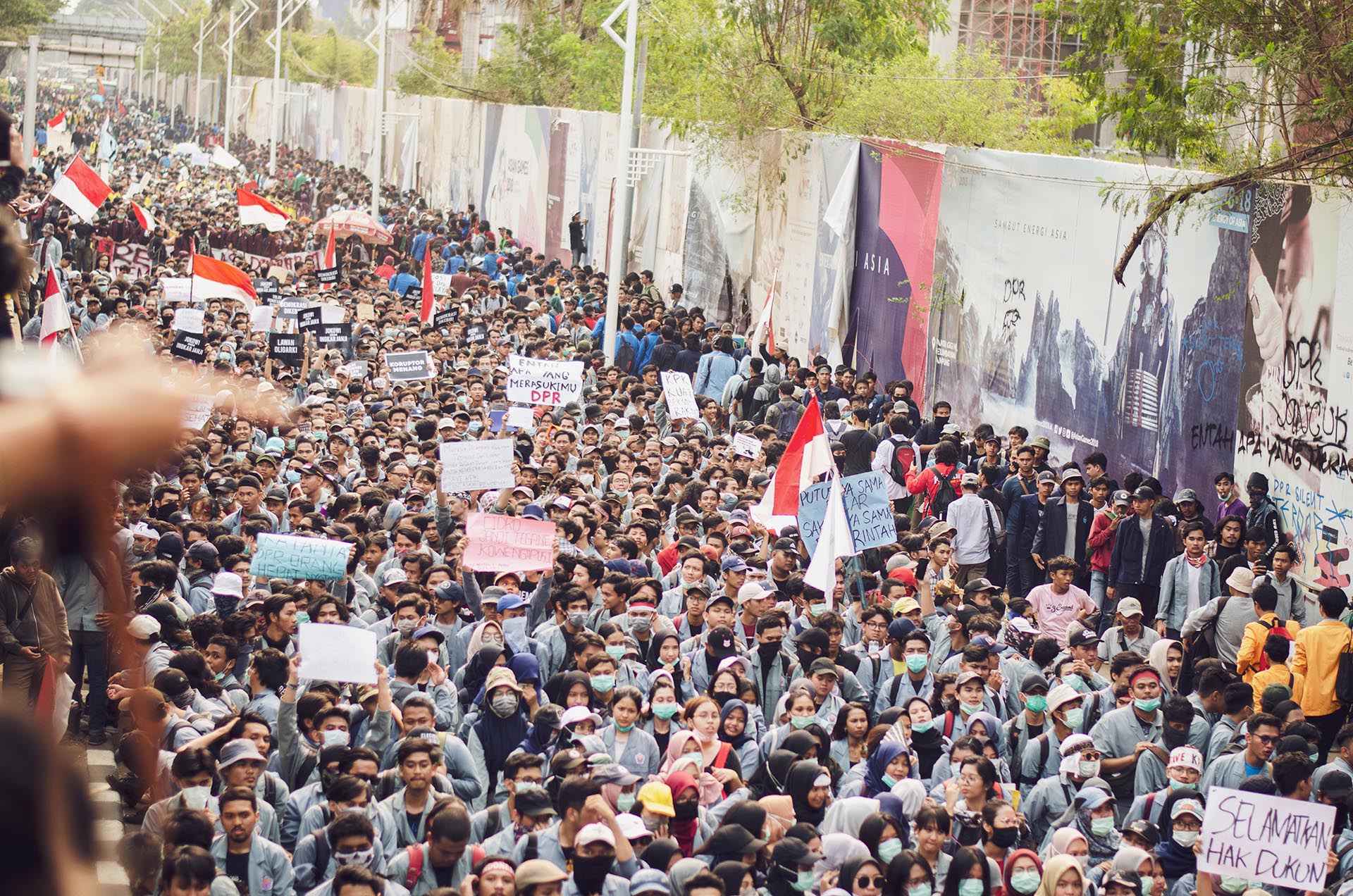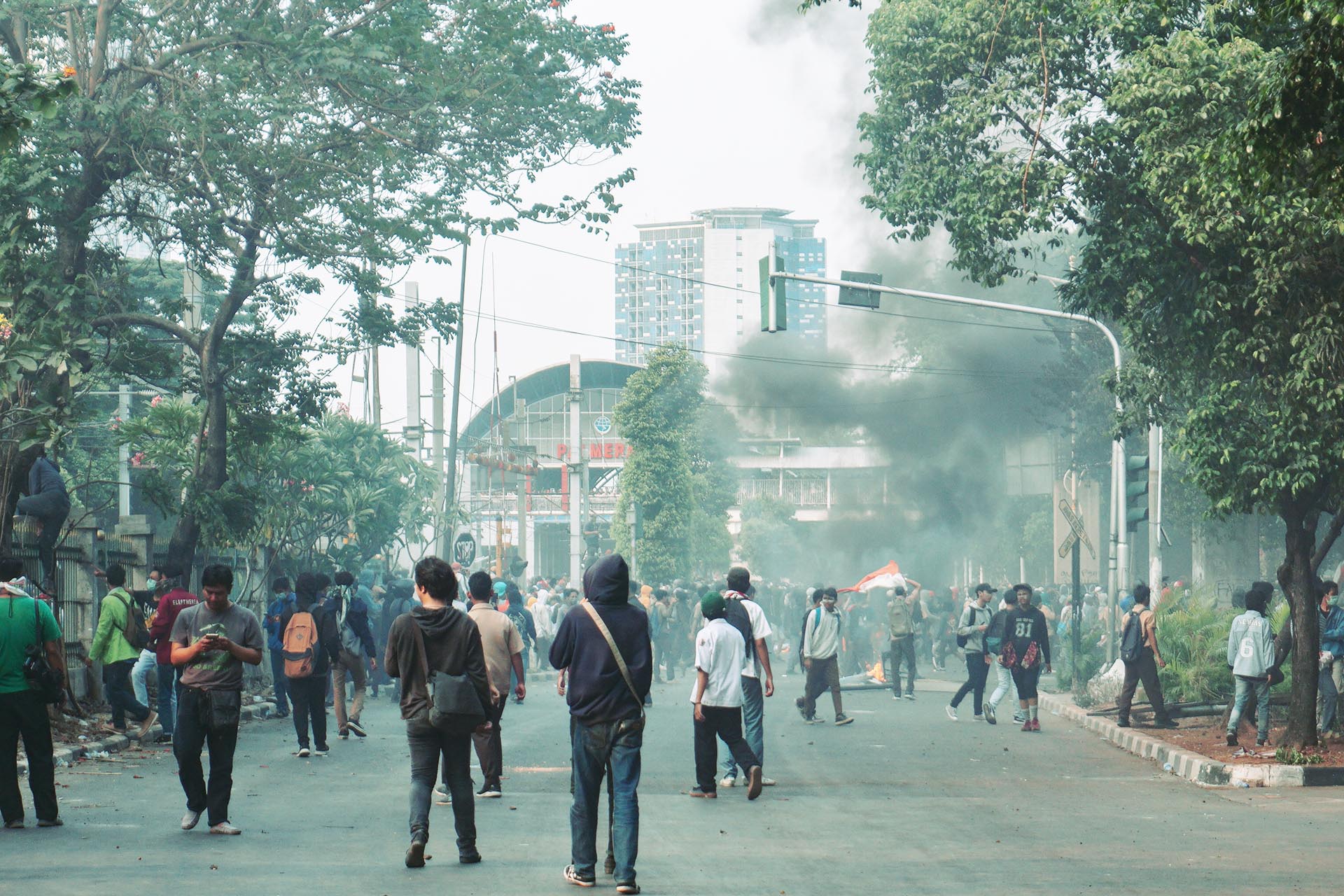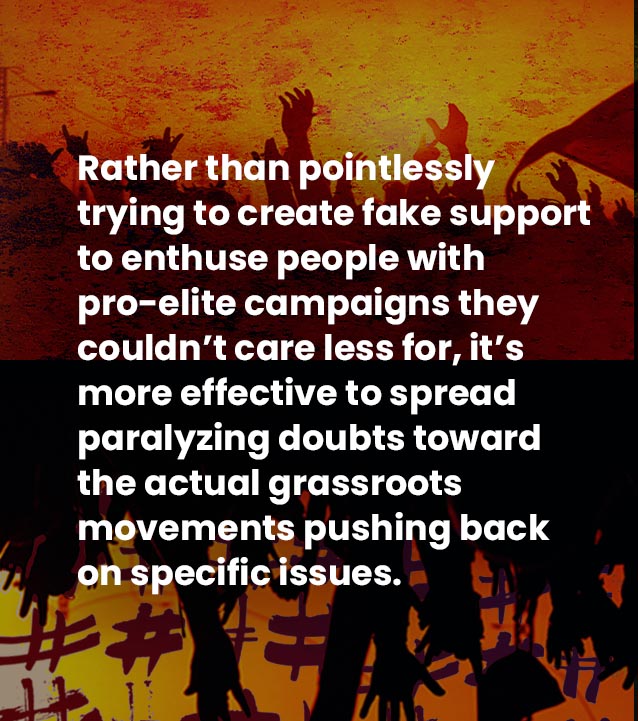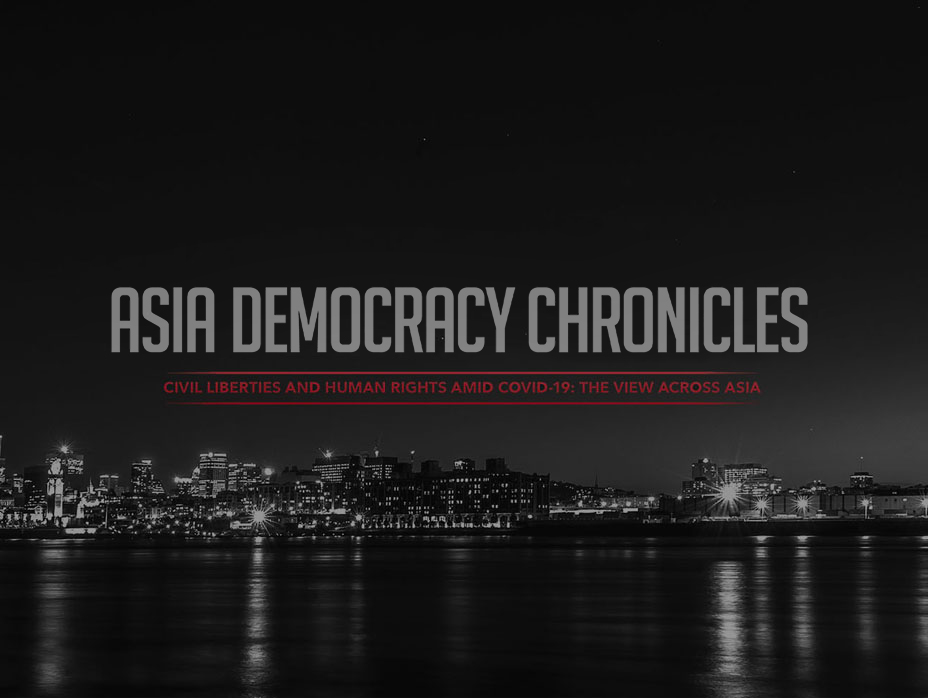It was nearly dark when I arrived on the streets leading to The People’s Representative Council building in Central Jakarta. A sea of people – university students wearing their distinct single-color alma mater jackets: dark blue, green, bright yellow, and maroon – lay on the ground stretching half a kilometer. Many were sitting down and stretching their tired legs, sore from hours of standing, while those with leftover energy formed barricades and rehearsed anti-establishment chants. Some of the more eccentric types even brought skateboards along, surfing their way through the crowd.
And it wasn’t only in Jakarta. September 23, 2019 marked the beginning of a massive movement that took place all across Indonesia and would continue for weeks to come.
Some hailed it as the nation’s largest pro-democracy movement since the 1998 Reformasi (Reform) movement that led to the fall of President Soeharto. This time around, the flames were ignited when the People’s Representative Council – Indonesia’s national legislative body – passed a bill that would weaken the Anti-Corruption Agency (KPK) by creating an Independent Supervisory Board – under the pretext of check and balance – to monitor and approve their activities, ranging from reconnaissance and crackdown to confiscation of goods from suspected violators.
The Board was in reality to be handpicked by the Council themselves, who had gained notoriety as an immensely corrupt institution over the years.
The people’s response was strong, but it would soon be clear that the ruling political parties were still just a few steps ahead, deploying underhanded tactics to discredit the mass movement.
One such tactic that has gained much traction among Indonesia’s ruling elite is astroturfing.
Astroturfing, according to one definition, refers to the attempt to create an impression of grassroots support for a policy, individual, or product where little such support actually exists.
The practice is best exemplified in the digital realm, where social media users have become aware of the existence of “buzzers” – an army of anonymous people contracted by politicians, corporations, and state institutions to amplify a topic or hashtag, and, in the process, control the public narrative and sway public opinion.
Astroturfers are quite easy to identify: on Twitter, buzzer accounts, usually with a low follower count, are created recently and have no history of other tweets besides issues they choose to tackle – be it slamming West Papua referendum efforts or promoting the disastrous use of palm oil to boost Indonesia’s GDP.
Provoking protesters
On that day in September 2019, as I walked toward the heart of the protests – the gates of the Council building complex – I stumbled upon a curious sight. Buzzers, it seemed, had crossed from cyberspace right into reality.
Just about a hundred meters away from the protests was a lone pickup truck. A makeshift podium was erected onto the vehicle, where a man was giving fiery speeches through a low-quality sound system to a nonexistent crowd.
Aside from a dozen or so bystanders catching air like I was, there was virtually no one else within a 50-meter radius from the one-man act. Perplexed by the sorry-looking scene, I sat down and paid closer attention. Just who is this person? Failing to see any organization or union banners hanging on the vehicle – usually a clear signifier of institutional representation in protests – I opted to listen carefully to his tirade:
“Listen! All of you! You protesters out there. You think you have any idea what you’re doing? You’re just a bunch of kids! You think you have idealism, but you know nothing! Let me ask you: who can ensure the KPK is clean? No one! In reality, they are just as corrupt. This is why we need to keep an eye on them. This is why we need to revise the KPK Law!”
That’s when it dawned on me: The man was a paid protester, a rather poorly planned one, based on the amount of ground support he painfully lacked.

On September 2019, university students from Indonesia stormed the streets to protest new legislation that would lopsidedly benefit the ruling elite. It has been said that the 2019 protests were on the same scale as the 1998 pro-democracy Reformasi movement that saw the downfall of then-President Soeharto.
At the time, the level of public support the KPK received in response to their institutional castration was overwhelming. Just several months before, a survey showed that trust in Indonesia’s Anti-Corruption Commission transcended the political divide, with 92 percent of President Joko “Jokowi” Widodo voters asserting their confidence toward the institution, along with 81 percent of Prabowo Subianto’s supporters – Jokowi’s two-time presidential election rival.
This consensus on anti-corruption, however, cannot be found among the political elite: in another survey, citizens across the archipelago mentioned corruption as the second-most important policy problem, while politicians only ranked it sixth, after economic growth, security, social welfare, education, and poverty.
It was then highly unlikely that an anonymous group of concerned citizens would voluntarily gather to endorse a piece of legislation lopsidedly benefitting the crony-capitalist elite. Yet that is exactly what they seemed to be doing: After half an hour or so of fruitless agitation, the nameless orator, gasping for air, called upon his companion to take his place.
“Hey! You protesters! Don’t pretend to be deaf! I know you can hear us. If you really have idealism, if you’re really as brave as you look, come and get us! There are only a few of us against your lot … you think we’re afraid? Come on!” shouted the companion.
If a group of protesters had taken the taunting seriously and responded in a hostile manner, the riot police on standby would immediately take action, leading to chaos and mass arrests. But their speakers were drowned out by the chants and shouts from tens of thousands of students, who were focused on the seemingly insurmountable eight-meter-tall steel gate standing between them and the Council building.
Not one protester was reported to have been arrested in Jakarta that night. The next several days, however, would tell a different, more brutal story.
The buzzers conundrum
Over the years, buzzers have gained domestic notoriety as an enigma in Indonesia’s political landscape, with academic journals and investigative reports attempting to dissect the phenomenon. Much of the public interest around them can be attributed to their shadowy nature. Everyone on social media knows they exist, but there’s very little information on these social media political operators: How are they recruited? Where does their money come from? Whose political interests do they push?
There is also the issue of their harmful effects on the country’s democracy. During the 2019 presidential elections, analysts pointed out that buzzers helped create a false sense of polarization between two major camps: pro-military nationalism, represented by Joko Widodo, and conservative Islam rallying behind Prabowo Subianto, himself a former Lieutenant General who fits comfortably with the nationalist position.
The buzzer playbook is quite easy to figure out. On matters of policy and ideology, both Jokowi and Subianto were nearly indistinguishable. What virtually every Indonesian voter understands, however, is the nationalist/religious divide, and – albeit vaguely – where citizens think they stand within (or beyond) it.
It is this most elementary, banal division that buzzers sought to exploit by flooding digital channels with provocations denouncing the other as not only a political rival, but ultimately an existential threat. In the end, politicians were able to stage a lukewarm election without having to dwell uncomfortably on ideological and policy contestations – the only thing that would lay bare their false conflict.
The curious case of buzzers, however, lies in how effectual they actually are outside elections. Authentic support toward an obviously elite-benefitting agenda, such as the bill on the KPK, has been proven near-impossible to engineer. Meanwhile, as the elections suggest, buzzers seem to work most effectively when they incite people to rally behind pre-existing social divisions rather than persuading them to jump ship.
Instead of changing public opinion, the primary function of astroturfing seems to lie in convincing others that some things, as they stand, cannot really change. In a sense, successfully maintaining social inertia is a battle nearly won.
What astroturfing so far has not been able to achieve, however, is to completely silence movements seeking social change. Yet there are already signs that those in power have started to figure out how to make that happen.
Reverse astroturfing
Three days after I watched the lone paid protester, the movement found themselves in disarray after hundreds of protesters were arrested for “lawless public incitement,” dealing a significant blow to their morale.
That day, however, a new, unthought-of group launched their own rally near the Council building: vocational high school students. Largely perceived as apolitical and coming from the lower-middle class, the students gathered in the thousands, only to clash with authorities and suffer the same fate as their university predecessors. By midnight, about 570 of them ended up being subdued by the police.
Then things turned weird. On September 30, a screenshot of a WhatsApp group, allegedly involving high school students, was leaked online. Its members complained that “their payment had not arrived yet,” implying that they were astroturfing rather than protesting on their own volition.

In the days after the government cracked down on the protests led by university students, a new unlikely leader emerged: vocational high school students. But this would set the stage for political machinations that ultimately would try to undermine mass movements.
After a savvy Twitter user ran the phone numbers on the screenshot – supposedly those of students – via the Truecaller app, it was found that they were actually those of police personnel, including contact names such as “Second Brigadier Raski from Police Headquarters” and “Anton from Mobile Brigade.”
The absurdity continues. A year later, on April 22, 2020, public policy researcher Ravio Patra woke up to find his WhatsApp hacked. When he finally retrieved his account six hours later, it was already filled with hateful messages denouncing him. It turned out that while he was locked out, someone used his number to message anonymous people, in all caps, saying:
“CRISIS IT’S TIME TO BURN! GATHER AND UNITE ON 30 APRIL FOR MASS NATIONAL LOOTING. ALL THE STORES IN YOUR VICINITY ARE FREE TO LOOT.”
Ravio, an activist known to be critical of the government, had been framed as a high-profile member of Indonesia’s boogeyman chaos-stirring anarchist group. Just the day before, he had confronted one of the President’s youth advisors, Billy Mambrasar, for a possible conflict of business interest; the previous week, he wrote an op-ed explaining the faulty statistics surrounding COVID-19 deaths employed by the National Board of Disaster Management that distorted the actually-horrifying state of Indonesia’s pandemic management.
Later that evening, after his hacker’s texting spree, police arrested Ravio on charges of public incitement. He was released the next day.
The message was clear: If it could happen to him, it could happen to anyone.
The red thread connecting cases such as Ravio’s and the high school students’ is a discernible attempt to frame activists and social movements as engineered, insincere, and ultimately malevolent. It further insinuates that the those involved in the resistance are the astroturfers. One might even call the scheme ensnaring them reverse astroturfing.
Rather than pointlessly trying to create fake support to enthuse people with pro-elite campaigns they couldn’t care less for, it’s more effective to spread paralyzing doubts toward the actual grassroots movements pushing back on specific issues.
What makes reverse astroturfing such a headache is that it shifts the burden of proof. Within conventional astroturfing, public attention is focused on the much-ridiculed buzzers who have to make the case for their pitch. Planting false evidence on another (proverbial) turf, on the other hand, entails police investigations and long court sessions.
While the public at large believes that what happened to the high school students was a setup, there is limited power in such a phenomenon if the legal system says otherwise. Most of the time, the authorities don’t even have to say anything but simply postpone a case indefinitely until the enraged masses cool down, which can happen very quickly.
Social inertia
All this leads back to the problem of social inertia. A campaign succeeds when it becomes interactive with the audience, eventually snowballing into a discourse larger than itself. What reverse astroturfing does, on the other hand, is to generate a discourse that cannot be tinkered even with mass feedback – a phenomenon dubbed interpassivity by theorists Robert Pfaller and Slavoj Žižek.
The term refers to the existence of a belief subscribed to by no one, but nonetheless affects many. This is what happens when researchers or journalists are accused of plotting a large-scale upheaval: no one actually believes the accusation, but everyone has to follow the legal procedure that implies it might be true after all.
An interpassive discourse succeeds precisely when no one can do anything about it, as no one can pinpoint who actually believes in the idea being bandied about. Who is its original possessor And no amount of debate or public ridicule will be able to do much, given the uncertainty around the real target of blame.
Yet one thing is certain for now: more and more people will stay late at night figuring out how to tackle a nonsensical accusation of public incitement. ●
Eduard Lazarus is a Jakarta-based journalist and editor writing on media and social movements.



















